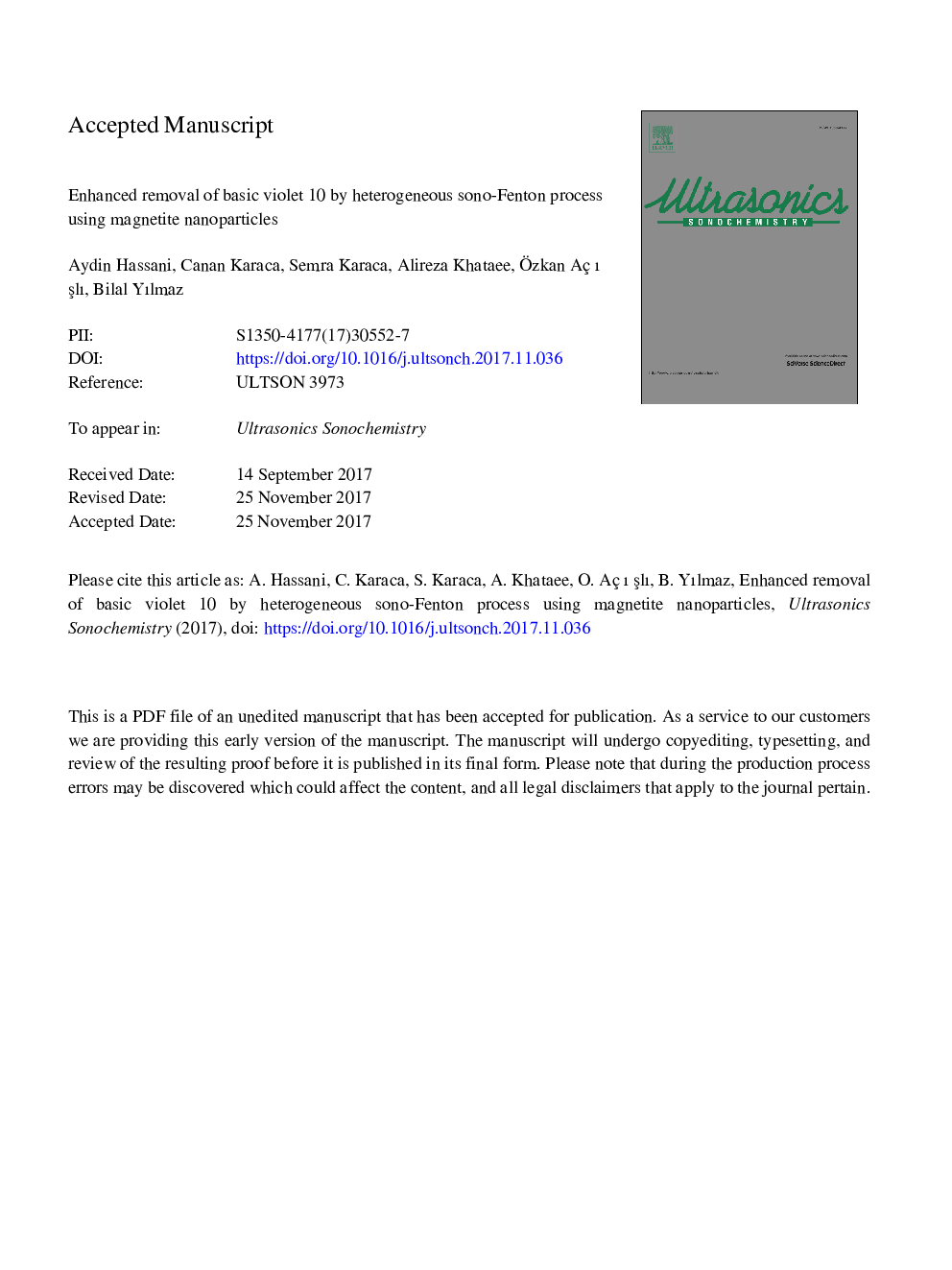| کد مقاله | کد نشریه | سال انتشار | مقاله انگلیسی | نسخه تمام متن |
|---|---|---|---|---|
| 7703289 | 1496862 | 2018 | 57 صفحه PDF | دانلود رایگان |
عنوان انگلیسی مقاله ISI
Enhanced removal of basic violet 10 by heterogeneous sono-Fenton process using magnetite nanoparticles
ترجمه فارسی عنوان
حذف فرآیند حذف بنفش پایه 10 به روش فرآیند سونو-فنتن ناهمگن با استفاده از نانوذرات مگنتیت
دانلود مقاله + سفارش ترجمه
دانلود مقاله ISI انگلیسی
رایگان برای ایرانیان
کلمات کلیدی
فرآیند آسیاب توپ، نانوذرات مگنتیت، سونو-فنتون ناهمگن، رنگ نساجی، تصفیه فاضلاب،
موضوعات مرتبط
مهندسی و علوم پایه
شیمی
شیمی (عمومی)
چکیده انگلیسی
The removal of basic violet 10 (BV10), which is known as a cationic dye, from aqueous solution was studied by employing a heterogeneous sono-Fenton process over the nano-sized magnetite (Fe3O4) which had been prepared by the milling of magnetite mineral using a high-energy planetary ball milling process. The magnetite samples were characterized using the X-ray diffraction (XRD), high resolution scanning electron microscopy (HR-SEM), energy-dispersive X-ray spectroscopy (EDX), Brunauer-Emmett-Teller (BET), Fourier transform infrared spectroscopy (FTIR), and inductively couple plasma mass spectrometer (ICP-MS). It was found that the catalytic activity of the ball-milled magnetite sample was enhanced along with the improvement in its physicochemical properties; also, the ball-milled magnetite of 6â¯h displayed the highest catalytic activity in BV10 removal by the heterogeneous sono-Fenton process as compared with that for 4â¯h (66.12% after 120â¯min) and 2â¯h (48% after 120â¯min).The effect of operational parameters, namely, pH solution, catalyst dosage, the initial H2O2 concentration, ultrasonic power and the initial BV10 concentration, on the removal efficiency (RE%) of BV10 was investigated. The optimum conditions for the BV10 RE% were: the pH value of 3, the catalyst dosage of 1.5â¯gâ¯Lâ1, the initial H2O2 concentration of 36â¯mM, the ultrasonic power of 450â¯Wâ¯Lâ1, and the initial BV10 concentration of 30â¯mgâ¯Lâ1. The RE% of BV10 was 75.94% at these conditions after the reaction time of 120â¯min. The trapping experiments revealed that OH radicals were the dominant oxidative species, but O2â/HO2 radicals also had a partial role in the removal of BV10.The reusability of the magnetite nanoparticles revealed about 28% decrease in the removal efficiency within five consecutive runs. The results obtained through GC-MS analysis also confirmed the efficient removal of BV10 molecules in the aqueous solution during the process.
ناشر
Database: Elsevier - ScienceDirect (ساینس دایرکت)
Journal: Ultrasonics Sonochemistry - Volume 42, April 2018, Pages 390-402
Journal: Ultrasonics Sonochemistry - Volume 42, April 2018, Pages 390-402
نویسندگان
Aydin Hassani, Canan Karaca, Semra Karaca, Alireza Khataee, Ãzkan AçıÅlı, Bilal Yılmaz,
